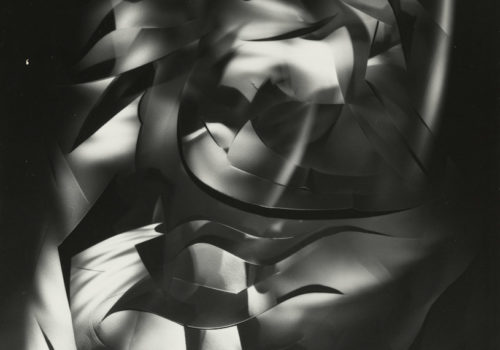Bringing together still and moving images, the MoMA exhibition A World of Its Own: Photographic Practices in the Studio explores the use of studio space by photographers and artists beginning in 1826. “In this digital age in which a younger generation of photographers is going back to the studio, I felt it was important to acknowledge the role played by this space in photography’s history,” Quentin Bajac, the first non-American to head the New York museum’s photography department, told Time magazine. (He arrived in January 2013.)
The exhibition features more than 150 photographs from the 19th century to today, including new acquisitions and pieces from the MoMA collection rarely seen in recent years. The introduction is provided by a fragmented piece from artist Bruce Nauman, whose work combines sculpture, video, sound, performance, neon and photography. An image of debris on the studio floor dating from 1967 takes on the appearance of a lunar surface.
Very quickly, though, the big names show up: Man Ray, Berenice Abbott, Harry Callahan, Cecil Beaton, Irving Penn, Julia Margaret Cameron, Eikoh Hosoe, Edward Steichen, Edward Weston, Cindy Sherman, Josef Sudek. However, much of the work on display is lesser known and ripe for rediscovery. In this multi-part journey through the history of photography—the studio as a laboratory, stage, playground—one has to wait for the middle of the exhibition to be surprised by lesser-known figures like Peter Hujar and his magnificent portraits of homosexuality, or the whimsical Laurie Simmons and Allan McCollum and their intriguing photographs of wax dolls. “I wanted to bypass the traditional categories associated with studio photography (portrait, advertisement, fashion, nude, etc.) and instead consider, in six different sections, the photographer’s studio as an autonomous space, in all its diversity and, sometimes, contradictions,” says Bajac.
While outdoor photography (street, documentary) has always been committed to portraying reality, the studio has always been a place of intense artistic creation. And that is what this exhibition attempts to demonstrate, the four walls within which the artist still finds solitude, this state that is vital to his or her existence. It’s where Philippe Halsman and Dali concocted their surrealist follies, where Francesca Woodman at first found refuge, then the psychological confinement which drove her to end her life. From these two photographers, strangely absent from the exhibition, and from those who are not, we learn that photographers may speak best when speaking to themselves, and to themselves alone.
EXHIBITION
A World of Its Own: Photographic Practices in the Studio
MoMA New York
Through October 5th, 2014
11 W 53rd St, New York, NY 10019
(212) 708-9400
















